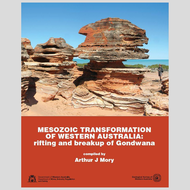Latest release in GSWA’s WA unearthed series
| Date: | Thursday, 29 June 2023 |
|---|
Mesozoic transformation of Western Australia: rifting and breakup of Gondwana is the latest release under the Geological Survey of Western Australia’s unearthed series.
The series is aimed at geologists, particularly newcomers to the State, looking to gain an understanding of the geology and economic potential of various terrains.
This volume focuses on the offshore North West Shelf, Australia’s premier hydrocarbon province. As a result of subdued tectonic events, the most significant resources in, or uses of, onshore Mesozoic strata are heavy mineral sand deposits on the Dampier Peninsula, water resources and gas storage.
Mesozoic transformation of Western Australia spans 252 to 66 Ma, an era represented by sedimentary deposits that cover about 23 per cent of the onshore part of the State and almost all offshore basins, with the Upper Jurassic – Cretaceous extending beyond the continent onto oceanic crust. These sedimentary successions are up to 15 kilometres thick in offshore depocentres and the Perth Basin. They contain only minor igneous rocks, apart from areas near the continent–ocean boundary, where intrusions are abundant.
A series of paleogeographic reconstructions paired with isopach images illustrates the Mesozoic depositional and structural history of the State and its surrounding waters. Each represent ‘time slices’ derived from regional correlations largely based on biostratigraphic studies. The four main phases of basin evolution are Triassic intracratonic rifting, Early–Middle Jurassic rifting, Late Jurassic – Early Cretaceous breakup and separation, and trailing-edge rifting and marginal sag. However, these phases are not synchronous, as there are differences between some areas in their timing, particularly with the progressive breaking away of continental fragments from north to south.
There is also a series of sections detailing other aspects such as mineralisation, other resources, fossils, impact features and provenance.

